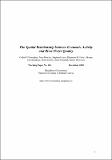The spatial relationship between economic activity and river water quality

View/
Date
2010-12Author
O'Donoghue, Cathal
Howley, Peter
Hynes, Stephen
Fealy, Réamonn
Chyzheuskaya, Aksana
Green, Stuart
Meredith, David
Morrissey, Karyn
Metadata
Show full item recordUsage
This item's downloads: 993 (view details)
Recommended Citation
O'Donoghue, C., Howley, P., Hynes, S., Fealy, R., Chyzheuskaya, A., Green, S., et al. (2010). The spatial relationship between economic activity and river water quality (Economics Working Paper no. 163): Department of Economics, National University of Ireland, Galway.
Abstract
This paper, using Ireland as a case study, examines the relationship between economic
activities and river water quality. The stipulation from the EU water framework
directive (WFD) that all surface waters in the EU must be of 'good ecological status'
by 2015 necessitate a quantitative understanding of the major determinants of water
quality. Within this context, this paper combines a number of spatial datasets relating
to agricultural, residential and industrial activities as well as the level of forest cover
to examine the major economic influences on the ecological quality of water
resources. It is hoped that providing a comprehensive understanding of the effect of a
variety of economic activities that influence the ecological quality of water will be an
important tool in the management of risk and will allow for more appropriate land use
planning aimed at restoring and maintaining water quality as required by the WFD.
Results indicate that the level of forestry, industrial activity, the intensity and type of
agricultural activity and the type of wastewater treatment in an area are all critical
factors affecting the quality of our water resources. Moreover, the results highlight the
importance of a spatial dimension to any analysis as the principal factors affecting
water quality often differ across river catchments.

